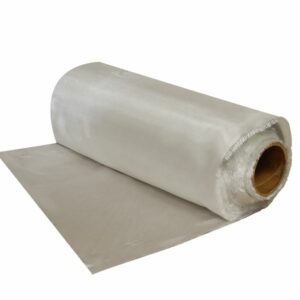Woven Roving and Glass Fibre Reinforcements
In the past few years, woven roving materials have become one of the most high-valued materials. Woven roving glass fibre reinforcements are mainly woven in a specific direction. Additionally, the 90-degree orientation to each other provides a decisive advantage.
Composite construction is used heavily in the shipping industry, military industry, aircraft industry, chemical industry, mica tape, fibreglass tape, and sports goods industry.
The following article provides a wide range of woven roving fabrics, including a detailed description.

Becoming Familiar with Woven Roving Glass Fibre Fabrics
- If used for constructing coverings or other composite frameworks, Roving is woven in a particular pattern to provide a high level of strength.
- In terms of direction wandering, you could also describe woven roving as the joining of direct wandering into a plain weave pattern.
- In the manufacturing process, the interweaving of the different glass filaments strengthens the fabric and makes it heavier because of its strengthened construction.
- In addition, these fabrics have the advantage that they are compatible with a broad range of resin systems.
What are the characteristics of woven roving fabric?
- Glass fibres are woven into a specified pattern to form woven Roving. Technical textile companies use continuous glass fibre roving to produce woven roving fabrics interwoven into significant burden fabrics.
- The company tended to expand the flexural and effect strength of laminates most of the time.
- In general, it is considered the standard ratio to determine the proportion of resin to reinforcement when weaving woven Roving.
- Weaved Roving is therefore available in a variety of weights, weaves, widths, and finishes to suit a variety of applications.
To make this fabric, you’ll need a few materials. There are two primary components of the resin system: (i) resin and (ii) fibre reinforcement. Initially, a liquid resin is a liquid, but later, it becomes a rigid but brittle solid when it hardens. In that case, we can refer to the fibres as the second kind of reinforcement. During the hardening process, the fibres are incorporated into the liquid resin. The fibres serve as reinforcements, and these reinforcements help give the resin its strength. A Trap plastic can be reinforced with many fabrics to maintain its tremendous power and stiffness.
Fabric reinforcements for woven roving fabrics
Various types of reinforcement fabrics are available on the market, and this article will provide you with some tips on selecting the most appropriate one. Generally speaking, there are several kinds of fibre reinforcement products available.
- Cloth: Two main types of cloth are available; one of them is a cloth, which ranges in width from one inch to fifty inches. Despite the wide variety of widths, the fabric has the appearance of an accurate weave design.
- Mat: The strands going in all directions are what people identify it. It is essential to point out that mats are not only capable of conforming to complex shapes and curves, but they also can conform to compound curves.
In polyester resin manufacturing, the glue used to take the fibres and fabrics together is dissolvable with polyester resin. When this happens, the fibres behave as papier mache and conform to shapes that would be nearly impossible for most other types of cloth.
- Roving: A woven product consisting of strands of woven fabric, such as grooving, has a coarse weave.
- Kaytex: It is most common to use both short strand mats and long strand rovings as reinforcement fibres in the construction process.
Producing woven roving fabrics requires consideration of several factors:
- Weight
- Strand direction
- Weave and fibre
- Fibre composition.
Weight: Fiberglass products are strong depending on the amount of reinforcement they contain, which contributes to their rigidity and strength. The mechanics, who are responsible for measuring weight per square yard, have long practised this practice. It is generally considered that fabrics with higher scale numbers are likely more robust than textiles with lower scale numbers.
When choosing a fabric for the intended purpose, it can be a challenge to find one that is both strong and durable without being overly heavy. The blend of fabric and plastic in composite fibreglass products allows users to achieve their desired purpose. It has 24 points, which can accommodate fabrics with a weight of up to 3.7 ounces per square yard. A choice of reinforcement is also influenced by the 9 ounces of material used in the construction.
Strand direction: Different fabrics can be made using a variety of fibres that can either be unidirectional or bidirectional, so they can be used to create different fabrics.
In what way does the fabric direction affect the appearance of a garment?
Polyurethane resin is used to construct a fabric that can be utilised unidirectionally, and the material is constructed with this resin. As a result, when the strands are attached in such a way, they become powerful. When the piece is rotated 90 degrees in this manner, the fibres are oriented in a downward direction, creating a negatively weakened direction. A fabric with bidirectional fibres has fibres oriented at 0 degrees and 90 degrees, resulting in two directions of fibre orientation. As a result of the fabric being used in both directions, the mat is essential for both approaches. There are fibres in every direction. Accordingly, the mat provides equal strength in both directions. When it comes to using the mat with clothes, it is generally advised that it is done over a rug. As a result, it is omnidirectional.
Weave and fibre: The fabric also has a third characteristic in addition to the waves. We mean by waves the pattern on the fabric. Two pieces of 9-ounce cloth must be woven together to make threats in this way. The material and fibre are the same, but the weights and directions of the fibres are different. Fabrics made from such materials are known as plain woven fabrics.
Fibre composition: Fibre composition is another critical factor to consider in addition to fabric characteristics.
E- glass: Fibreglass fabric is two reasons why it is the most economical textile on the market – it is made from microscopic glass fibres that are woven together. There is no fabric on the market today that has more threads per square inch than fibreglass fabric.
S-glass: Additionally, S-glass can be used as a fabric. The chemical tempering of the glass enables it to have greater strength than ordinary glass since it has been chemically tempered.
Carbon fibres: The third type of fibre is known as carbon or graphite. Its low weight and rigid nature make it easy to identify thanks to the black appearance of carbon fibres as well as the low weight, which makes it easy to distinguish. It should be noted that these materials are not only used in sailing competitions but are also used in both military aircraft and commercial aircraft.
Aramid
Aramid fabric is the fourth type of fabric, and Kevlar is undoubtedly one of the most recognisable brands. The lightweight, direction of the fibres, the kind of weave, and the fabric’s composition result in a highly impact-resistant fabric and can be used for areas exposed to force. To achieve the best performance, you should carry as little weight as possible. One way to do this is by using plastic taps made from various materials.
Fabrics made from woven roving yarns are separated into two types:
The ability to Wet out the material with great force and speed.
This service allows you to customise your wet out to meet your specific needs.
Static electricity and corrosion prevention will be applied to each product.
This material is particularly appealing because it has suitable drapes, dries quickly, and provides adequate coverage.
It is most commonly available in plain weave patterns, but other weave patterns can be installed upon request.
Weaved roving fabrics: applications
It is usually the uneven weave of woven packs that causes these problems. It may not be feasible for the second material to be added or moved. A large number of voids will occur if this is the case. The resin added to fill in those voids will also make a considerable difference in the outcome of the project. Nevertheless, it will still make a significant difference in the project’s outcome.
It is known that woven Roving has a wide range of applications that make it an extremely valuable product. Woven fibreglass roving fabric is applied to various applications, including truck bodies, aeroplane engines, canoes, surfboards, tank shells, and wind turbine blades. It is important not to fold the fabric when handling it, which could result in the material becoming damaged due to folding. The paper can be rolled into a tube instead of rolling it into a tube so that wrinkles can be avoided while the paper is being rolled. For a builder to determine how much reinforcement is required, they must select the suitable fabric.
